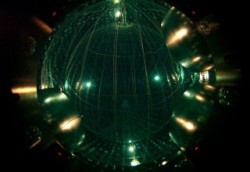Mar 29 2010
Two researchers Andrea Pocar and Laura Cadonati of the University of Massachusetts Amherst are measuring geo-neutrinos – some of the most rare particles detected ever – using a device called Borexino.
 Inside the scintillator at Borexino
Inside the scintillator at Borexino
The measured data revealed a precise signal of geo-neutrino particles present deep within the Earth.
The researchers, who are part of the Borexino international group, received funds from the National Science Foundation for this assignment. The Borexino device was placed underground at the Laboratorio Nazionale del Gran Sasso in Italy for this measurement purpose. The device was operated by the Institute of Nuclear Physics of Italy.
Formed by the radioactive decaying of rubidium, thorium, potassium and uranium, geo-neutrinos are basically anti-neutrinos present in ancient rocks deep inside Earth. Such decaying is known to generate heat inside the planet, which affects volcanic activity and movements in tectonic plates. Basically, Borexino is a large neutrino detector used for investigating deep into the core of the planet.
Borexino detects anti-neutrinos which interact in its scintillator fluid, which in turn is contained in a 300-ton sphere and let out their energy as small light flashes when particles move through it. It is hard and difficult to detect neutrinos as they have a negligible mass and no electric charge and they do not sense strong nuclear or electromagnetic forces.
Borexino, being one of the world’s few underground detectors presently available, is promoted by institutions from France, Poland, Russia, Germany, Italy and the U.S. Developed to study and observe neutrinos generated inside the Sun, the device is one of the world’s most effective observatories.
Borexino is not the first option in the detection of geo-neutrinos as the year 2005 saw a Japanese–United States partnership operating a similar device for measuring these particles. However, those measurements were not precise as they were interfered by radioactive background noise. In comparison, the measurements recorded by Borexino are far more precise.
Going forward, international researchers believe that observations from Borexino in Italy and other similar detectors located in Japan and Canada can be coordinated for improving the detection of geo-neutrino particles.